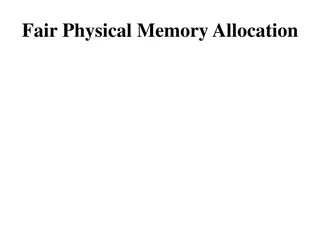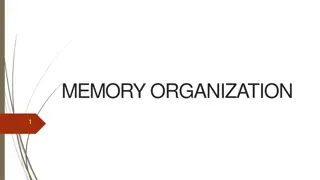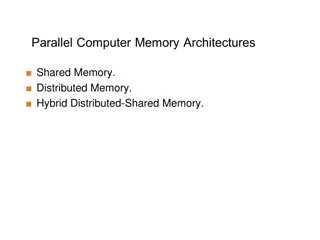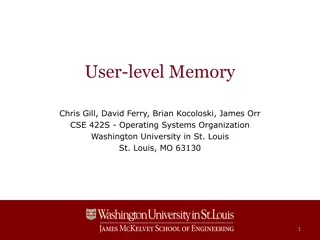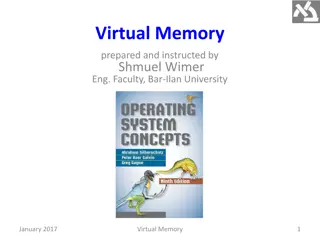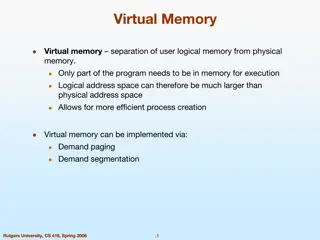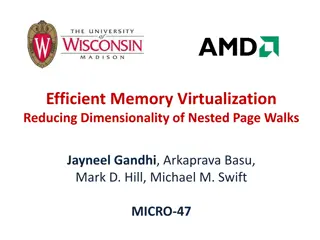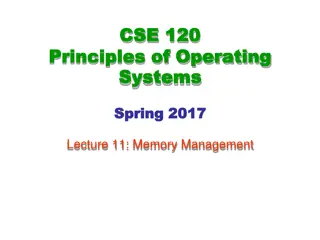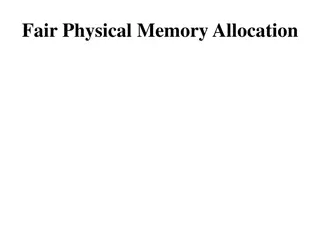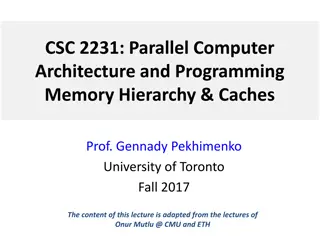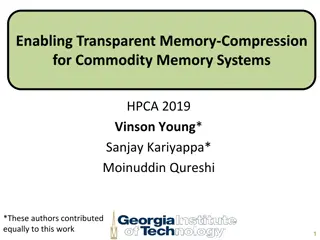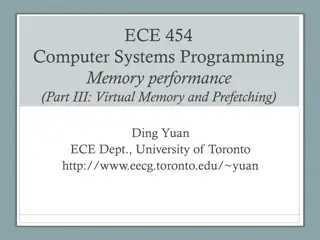Virtual Memory
Virtual memory plays a crucial role in optimizing system performance by extending physical memory capacity. It allows for efficient multitasking and enables larger programs to run by temporarily transferring data from RAM to disk. Understanding virtual memory management is essential for maintaining system stability and enhancing overall productivity. Learn about the benefits and functionality of virtual memory in this comprehensive guide.
Download Presentation

Please find below an Image/Link to download the presentation.
The content on the website is provided AS IS for your information and personal use only. It may not be sold, licensed, or shared on other websites without obtaining consent from the author.If you encounter any issues during the download, it is possible that the publisher has removed the file from their server.
You are allowed to download the files provided on this website for personal or commercial use, subject to the condition that they are used lawfully. All files are the property of their respective owners.
The content on the website is provided AS IS for your information and personal use only. It may not be sold, licensed, or shared on other websites without obtaining consent from the author.
E N D
Presentation Transcript
Virtual Memory LibA LibB LibA LibB LibC Prog Disk data heap LibC Prog data Program stack Process 1 LibC Prog Phys Memory
Virtual Memory Mechanisms If page fault (i.e., present bit is cleared) Trap into OS (not handled by hardware. Why?) OS selects victim page in memory to replace Write victim page out to disk if modified. Add modified ( dirty ) bit to PTE OS reads referenced page from disk into memory Page table is updated, present bit is set Process continues execution What should scheduler do?
Mechanism for Continuing a Process Continuing a process after a page fault is tricky Want page fault to be transparent to user Page fault may have occurred in middle of instruction When instruction is being fetched When data is being loaded or stored Requires hardware support precise interrupts: stop CPU pipeline such that instructions before faulting instruction have completed, and those after can be restarted Complexity depends upon instruction set Can faulting instruction be restarted from beginning? Example: move +(SP), R2 Must track side effects so hardware can roll them back if needed
Virtual Memory Policies Goal: Minimize number of page faults Page faults require milliseconds to handle (reading from disk) Implication: Plenty of time for OS to make good decision OS has two decisions Page selection When should a page (or pages) on disk be brought into memory? Page replacement Which resident page (or pages) in memory should be thrown out to disk?
Average Memory Access Time (AMAT) Hit% = portion of accesses that go straight to RAM Miss% = portion of accesses that go to disk first Tm = time for memory access Td = time for disk access AMAT = (Tm) + (Miss% * Td)
Page Selection When should a page be brought from disk into memory? Demand paging: Load page only when page fault occurs Intuition: Wait until page must absolutely be in memory When process starts: No pages are loaded in memory Problems: Pay the cost of a page fault for every newly accessed page
Page Selection When should a page be brought from disk into memory? Pre-paging (anticipatory, prefetching): Load page before referenced OS predicts future accesses (oracle) and brings pages into memory early Works well for some access patterns (e.g., sequential) Problems?
Page Selection When should a page be brought from disk into memory? Hints: Combine above with user-supplied hints about page references User specifies: may need page in future, don t need this page anymore, or sequential access pattern, ... Example: madvise() in Unix
Page Replacement Which page in main memory should selected as victim? Write out victim page to disk if modified ( dirty bit set) If victim page is not modified (clean), just discard OPT: Replace page not used for longest time in future Advantages: Guaranteed to minimize number of page faults Disadvantages: Requires that OS predict the future; Not practical, but good for comparison
OPT Replacement Example Page reference string: 1,2,3,1,2,4,1,4,2,3, 2 OP T Miss: 1,2,3 Three pages of physical memory Metric: Miss count
OPT Replacement Example Page reference string: 1,2,3,1,2,4,1,4,2,3, 2 OP T Miss: 1,2,3 Three pages of physical memory Metric: Miss count : 3 1 2 3
OPT Replacement Example Page reference string: 1,2,3,1,2,4,1,4,2,3, 2 OP T Miss: 1,2,3 Three pages of physical memory Metric: Miss count : 3 Compulsory misses 1 2 3 Hit 1 1 2 3 1 2 3 Hit 2
OPT Replacement Example Page reference string: 1,2,3,1,2,4,1,4,2,3, 2 OP T Miss: 1,2,3 Three pages of physical memory Metric: Miss count: 4 capacity miss 1 2 3 Hit 1 1 2 3 1 2 3 Hit 2 Miss:4, Replace: 3 1 2 4 Hit 1 1 2 4
OPT Replacement Example Page reference string: 1,2,3,1,2,4,1,4,2,3, 2 OP T Miss: 1,2,3 Three pages of physical memory Metric: Miss count: 4 1 2 3 Hit 1 1 2 3 1 2 3 Hit 2 Miss:4, Replace: 3 1 2 4 Hit 1 1 2 4 Hit: 4 1 2 4 Hit: 2 1 2 4
OPT Replacement Example Page reference string: 1,2,3,1,2,4,1,4,2,3, 2 OP T Miss: 1,2,3 Three pages of physical memory Metric: AMAT? Miss count : 5 1 2 3 Hit 1 1 2 3 5 misses, 4 compulsory misses 1 2 3 Hit 2 Miss:4, Replace: 3 1 2 4 AMAT = (Tm) + (Miss% * Td) Hit 1 1 2 4 Hit: 4 1 2 4 Assume Tm = 100ns Assume Td = 1000000 ns (1millisec) Hit: 2 1 2 4 Miss:3, Replace: 1 2 3 4 AMAT = ? Hit: 2 2 3 4
FIFO FIFO: Replace page that has been in memory the longest Intuition: First referenced long time ago, done with it now Advantages: Fair: All pages receive equal residency; Easy to implement (circular buffer) Disadvantage: Some pages may always be needed
FIFO Example Page reference string: 1,2,3,1,2,4,1,4,2,3,2 OP T Miss: 1,2,3 Three pages of physical memory Metric: Miss count: 3 1 2 3
FIFO Example Page reference string: 1,2,3,1,2,4,1,4,2,3,2 OP T Miss: 1,2,3 Three pages of physical memory Metric: Miss count: 4 1 2 3 Hit: 1 1 2 3 Hit: 2 1 2 3 Miss:4, Replace:1 2 3 4
FIFO Example Page reference string: 1,2,3,1,2,4,1,4,2,3,2 OP T Miss: 1,2,3 Three pages of physical memory Metric: Miss count: 5 1 2 3 Hit: 1 1 2 3 Hit: 2 1 2 3 Miss:4, Replace:1 2 3 4 Miss:1, Replace:2 3 4 1 Hit: 4 3 4 1
FIFO Example Page reference string: 1,2,3,1,2,4,1,4,2,3,2 OP T Miss: 1,2,3 Three pages of physical memory Metric: Miss count : 7 1 2 3 Hit: 1 1 2 3 Hit: 2 1 2 3 Miss:4, Replace:1 2 3 4 Miss:1, Replace:2 3 4 1 Hit: 4 3 4 1 Miss:2, Replace:3 4 1 2 Miss:3, Replace:4 1 2 3
FIFO Example Page reference string: 1,2,3,1,2,4,1,4,2,3,2 OP T Miss: 1,2,3 Three pages of physical memory Metric: Miss count : 7 1 2 3 Hit: 1 1 2 3 Hit: 2 1 2 3 Miss:4, Replace:1 2 3 4 Miss:1, Replace:2 3 4 1 Hit: 4 3 4 1 Miss:2, Replace:3 4 1 2 Miss:3, Replace:4 1 2 3 Hit: 2 1 2 3
FIFO Example Page reference string: 1,2,3,1,2,4,1,4,2,3,2 OP T Miss: 1,2,3 Three pages of physical memory 1 2 3 7 total misses, 4 compulsory misses Hit: 1 1 2 3 Hit: 2 1 2 3 Miss:4, Replace:1 AMAT = (Tm) + (Miss% * Td) 2 3 4 Miss:1, Replace:2 3 4 1 Assume Tm = 100ns Assume Td = 1000000 ns (1millisec) Hit: 4 3 4 1 Miss:2, Replace:3 4 1 2 AMAT = ? Miss:3, Replace:4 1 2 3 Hit: 2 1 2 3
LRU Example Replace Least Recently Used Page reference string: 1,2,3,1,2,4,1,4,2,3,2 OP T Miss: 1,2,3 Three pages of physical memory Metric: Miss count 5 total misses 4 compulsory misses 1 2 3 Hit: 1 1 2 3 In this example, same as OPT! Hit: 2 1 2 3 Miss:4, Replace:3 1 2 4 Hit: 1 1 2 4 Hit: 4 1 2 4 Hit: 2 1 2 4 Miss:3, Replace:1 2 4 3 Hit: 2 2 4 3

























